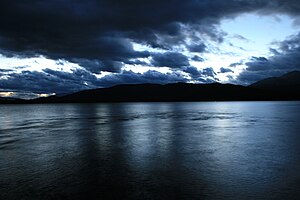Richard Henry - Arguably New Zealand's first conservation hero...
| English: Lake Te Anau taken at night, just outside town of Te Anau (Photo credit: Wikipedia) |
He spent much of his time in the Te Anau region, working as a shepherd, boatman and carpenter, and gaining much recognition and admiration for his knowledge of the native wildlife. He was also one of the first to raise the alarm about the growing impact of stoats, ferrets and weasels, which were introduced to try to combat the rabbit plague.
Stoats, weasels and ferrets were introduced in 1882 as the "natural enemies" of the rabbits and despite dire warnings from respected scientists in Britain and in New Zealand, the government continued to import and breed thousands of these mustelids at the behest of the pastoral lobby. It didn't take long (as predicted by naturalists like Andreas Reischek and Walter Buller) for the stoats and their cousins to change tack and gain an appetite for the large, mostly flightless native birds.
Richard Henry outside his boatshed, Pigeon Island, Dusky Sound, Fiordland, March 1900
Richard Henry, living in the bush and in a front row seat to see the devastation, watched helplessly as his once common kakapo and kiwi neighbours disappeared in front of his eyes.
"On the west, from the mouth of the Waiau for 25 miles of beach, there are neither signs nor sounds of kakapo, weka, nor kiwi, where they used to be numerous, but there are plenty of ferret tracks on the beach. Up the creeks in the bush grey teal and blue duck were plentiful, but now they are all gone, and the black teal are rapidly going also, and in all probability will soon be simply a memory of the past."
http://www.stuff.co.nz/national/blogs/in-our-nature/8148091/Our-first-conservation-hero
Ecospree









0 Comments:
Post a Comment
Subscribe to Post Comments [Atom]
<< Home